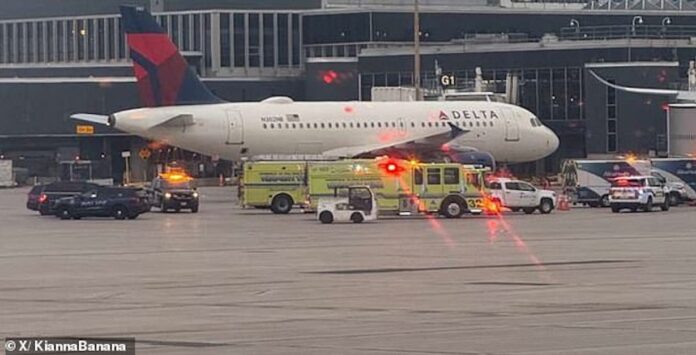- Severe turbulence on Delta Flight 56 forced an emergency landing in Minneapolis, injuring at least 25 passengers.
- Passengers were thrown from seats, with some potentially suffering broken bones; emergency crews met the plane on arrival.
- Public concern rises over airline safety and turbulence warnings, as experts link increasing incidents to climate-related changes.
What started as a routine international journey turned into a harrowing ordeal for hundreds aboard a Delta flight when sudden, violent turbulence struck midair and forced a dramatic emergency landing. Dozens of passengers suffered injuries after the plane lurched with terrifying force, sending many flying out of their seats.
Delta Flight 56, bound for Amsterdam from Salt Lake City, carried 275 passengers and 13 crew members. It lifted off around 4:35 p.m. local time on Wednesday, but just a few hours later, pilots diverted the aircraft to Minneapolis-St. Paul International Airport. They touched down safely at approximately 7:45 p.m. local time.
A Sudden Drop Shocks Passengers Mid-Flight
Passengers described a peaceful cabin just moments before the chaos began. Some read quietly, others dozed off or chatted with neighbors. Then, without warning, the plane dropped. Screams filled the cabin. Those without seatbelts slammed into overhead bins or other passengers.
“It felt like we hit a giant pothole in the sky,” one traveler said. “People flew out of their seats. It was complete panic.”
Flight attendants rushed to help. They comforted passengers, checked injuries, and tried to calm children who had started crying. Scattered drinks, food trays, and luggage turned the aisles into a mess. Blood stained several seatbacks where passengers hit hard surfaces. One woman held a tissue to her face, shaken and bleeding from the nose.
Despite their own fear, the flight crew moved swiftly and stayed focused. They assisted injured passengers while maintaining communication with the cockpit.
Emergency Crews Rush In at Landing
When the plane landed in Minneapolis, emergency responders stood ready on the tarmac. Firefighters, EMTs, and airport medics stormed the gate to evaluate the situation.
Paramedics transported 25 passengers to local hospitals for further care. Most suffered cuts, bruises, or sprains, but early reports suggested that some might have broken bones.
“We don’t see this kind of situation every day,” said one Minneapolis emergency responder. “It was serious. People looked scared, hurt, and very shaken.”
Delta issued a statement shortly afterward, thanking the emergency crews. “Our Delta Care Team immediately began assisting customers after landing. Safety remains our top priority,” a spokesperson said.
Passengers Question Airline Communication
Many injured passengers expressed anger and confusion in the hours following the ordeal. Some blamed the airline for not issuing a warning before the turbulence struck.
“I wasn’t buckled,” said a Dutch tourist. “No one told us anything. The seatbelt sign wasn’t even on.”
Another passenger, returning from a business trip, echoed that frustration. “I understand turbulence happens. But they should’ve said something. A warning might have saved a few injuries.”
The lack of communication stirred debate online. Social media platforms lit up with furious comments and worried travelers. Family members of passengers shared their fears, while aviation experts and climate analysts offered insight into why turbulence seems to grow more frequent and violent.
“I fly often, but this makes me want to avoid planes entirely,” one user posted on X (formerly Twitter).
Scientists Warn About Stronger Turbulence
Aviation analysts pointed to an unsettling trend. As jet streams shift due to climate change, severe turbulence grows more unpredictable. Flights crossing major ocean routes, especially between North America and Europe, now encounter more “clear air turbulence”—the kind radar can’t detect.
Dr. David Powell, an aviation consultant, explained the problem. “Jet stream patterns change, and we see stronger wind shears at cruising altitude. Pilots train for these scenarios, but sometimes they don’t see it coming.”
Experts say the industry must reconsider turbulence protocols. More frequent turbulence could mean longer periods with the seatbelt sign on, slower beverage service, and updated flight paths during certain seasons.
What Happens Now for Injured Passengers?
Delta’s Care Team contacted affected passengers directly and offered assistance with rebooking, medical support, and accommodation if needed. Legal advisors say the airline might face deeper scrutiny if investigators discover gaps in safety procedures or communication.
Some passengers already began exploring possible legal options. “I broke my wrist and missed two connecting flights,” said one injured traveler. “It’s not just physical pain. It wrecked my plans and cost me thousands.”
Others simply feel grateful to walk away. “It was the scariest moment of my life,” said a college student from Utah. “But I’m alive. And I’ll never forget that crew. They were amazing.”
Industry Faces a Wake-Up Call
Investigators will now review black box data, cockpit recordings, and flight reports to determine exactly what caused the incident. The FAA has not yet commented, but aviation authorities typically investigate any event with multiple injuries.
In the meantime, the story of Flight 56 sends a clear message to airlines and travelers alike: turbulence remains a serious threat, and it demands more than a shrug and a seatbelt sign.
As public concern grows, airlines face pressure to improve communication, adopt new safety protocols, and respond more quickly to sudden atmospheric threats.
Delta Flight 56 may have landed safely, but it left behind shaken travelers, unanswered questions, and a renewed urgency to keep passengers safe at every altitude.




